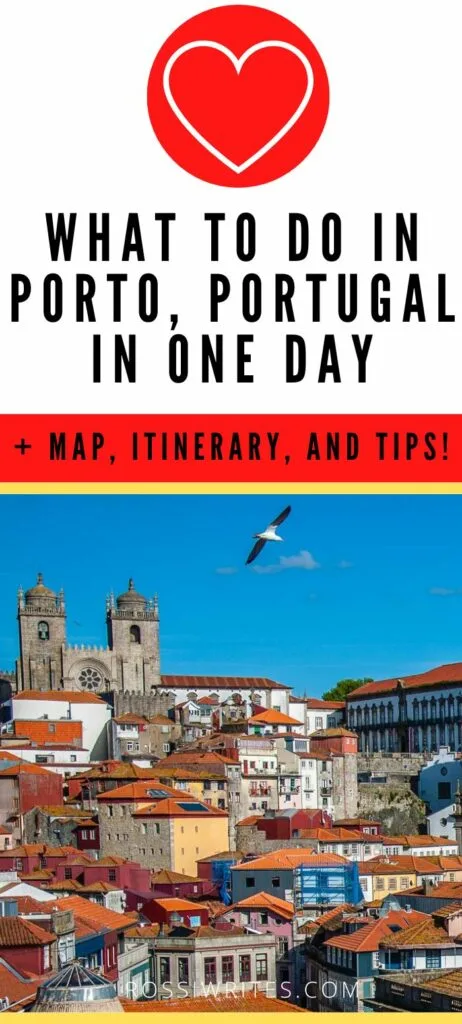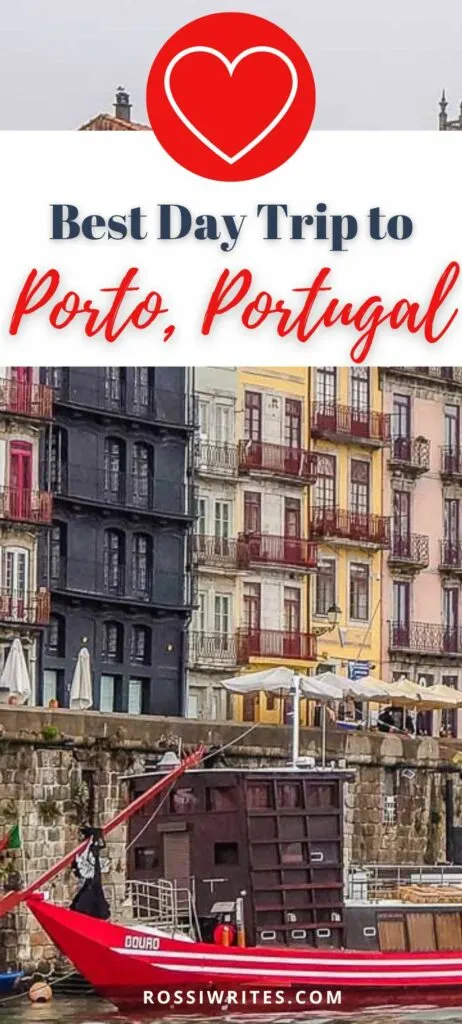Here is what to do in Porto in one day – from the major landmarks to the hidden corners of Portugal’s second-largest city.
With a historic centre built on a steep slope at the mouth of the River Douro and a long list of things to do, see, and enjoy, Porto is one of Europe’s most vibrant cities and an unmissable destination in Portugal. Even if you have just a day!
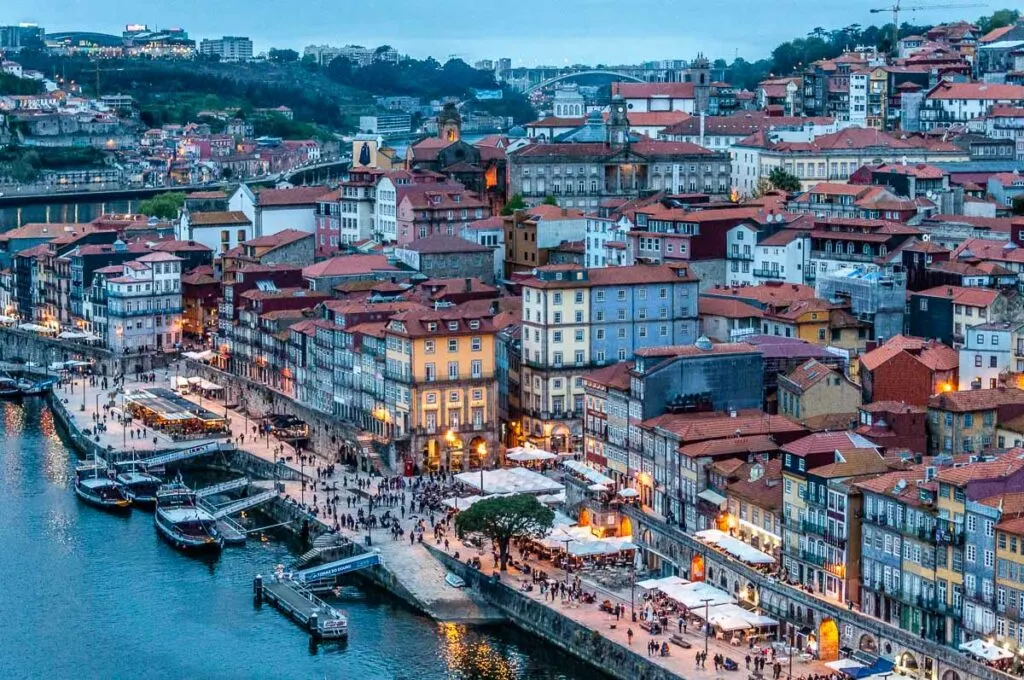
‘Is one day enough for Porto though?’, you may ask. And the honest answer will be ‘No! Of course, not! Yet, it’s a good start!’.
One day is more than enough to tick off many of Porto’s main sights and hidden gems. With a bit of careful planning, one day is perfect to get a taste of this exciting city – from its architecture and panoramic views to its prized wines and food.
So, if you are already thinking of spending time in either Northern or Central Portugal or Galicia in Spain and you are looking for a great day trip in the area, Porto is your main contender. Even if you are further south, in Lisbon, for example, Porto is still doable in a day. In this blog post, I will tell you how.
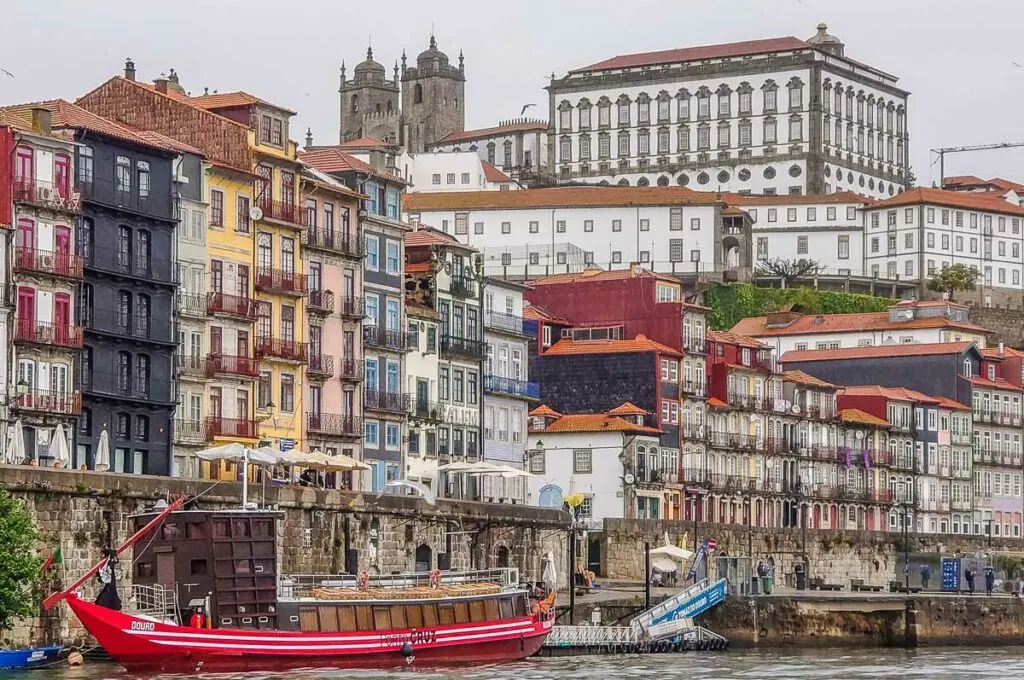
As luck would have it, my first two visits to Porto were indeed day trips. Both happened many years ago. Yet, I still remember the excitement of walking across the tall Dom Luís I Bridge over the sparkling waters of the River Douro.
This was followed by a tour of the cellars of Sandeman – one of the oldest port wine producers here. Then, a river cruise made the trip even better. It was a hot summer day and the jewel-coloured azulejo-clad facades of Ribeira – Porto’s ancient nucleus – seemed to sparkle in the sun.
My last visit to Porto – this past spring – stretched over several days. It gave me a chance to reacquaint myself with the city, explore it more thoroughly, and see it both in the glare of the sun and through the thick curtains of rain.
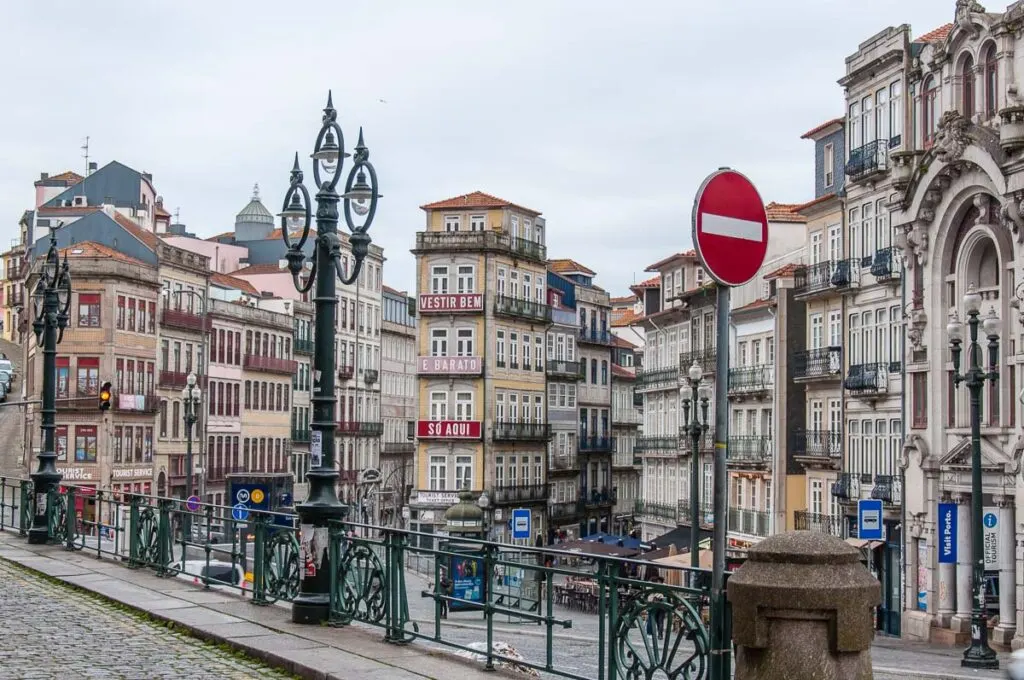
So, what can I tell you?! Porto is a must-see even if you have just a day. In this blog post, I have laid out for you a detailed one-day itinerary for Portugal’s second-largest city. From churches and palaces to port wine and a francesinha sandwich, it takes in the best things to do in Porto. Including the world’s most beautiful bookshop!
It is a hectic itinerary, yet so easy to customise. It combines history with panoramas and architecture with gastronomy. It will take you on the River Douro and through some of Porto’s secret corners. Yet, you can adjust it to reflect your particular interests. I have included a map of the itinerary and you can easily rearrange it to suit you.
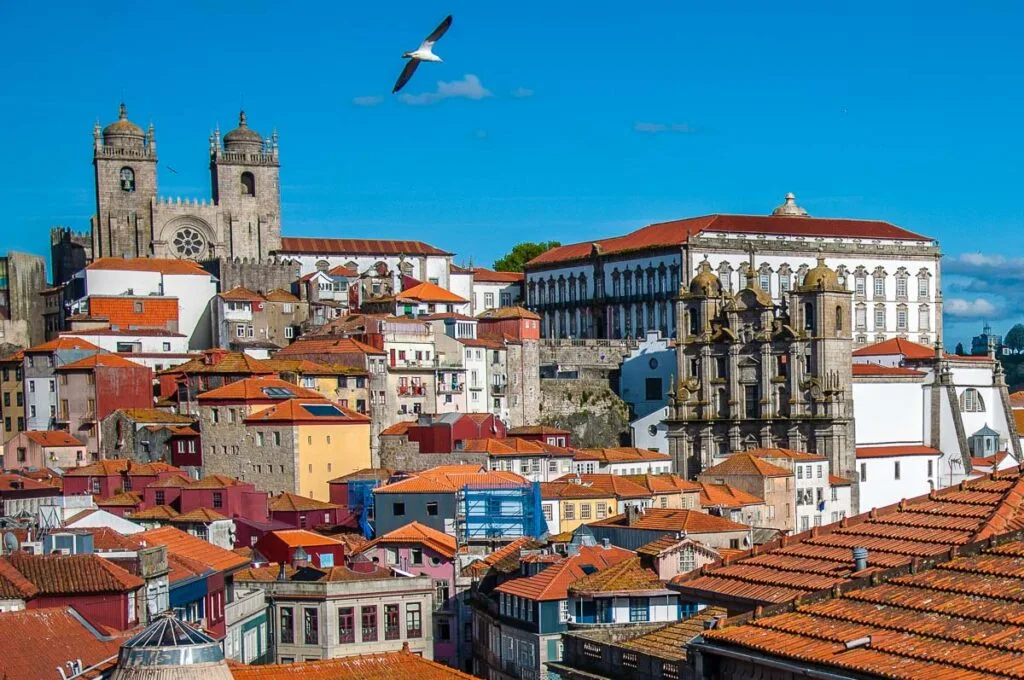
To make your travel planning for the city of Porto in Portugal an easy and enjoyable experience, at the end of this blog post I have also included food and shopping recommendations, lots of practical tips as well as a helpful section about how to get to Porto by plane, car, train, bus or organised trip.
You can also have a look at this blog post to get a visual idea of Portugal’s second-largest city before you head there:
Otherwise, let’s start!
What to Do in Porto in One Day – The Perfect Itinerary for a Day Trip to Portugal’s Second-Largest City
Pin for Later!
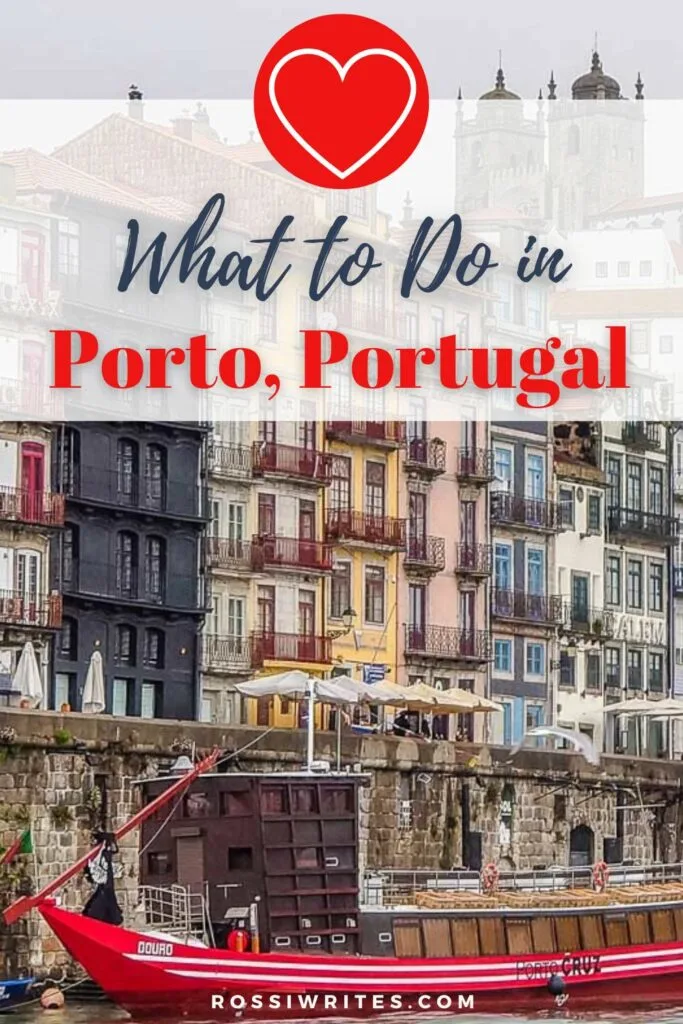
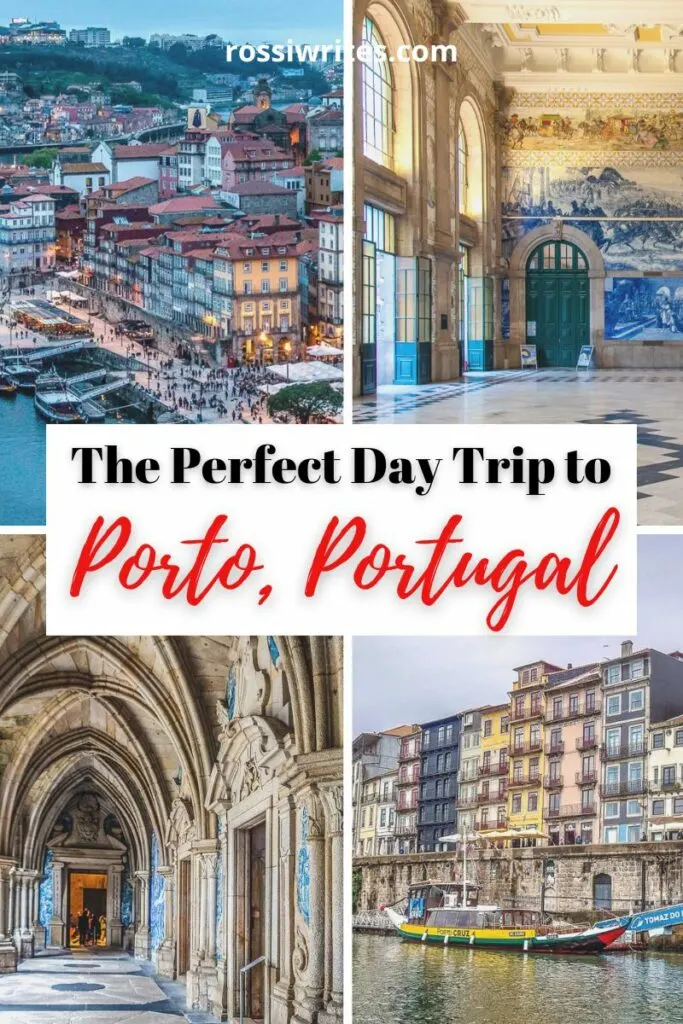
Start of this One-Day Itinerary for Porto, Portugal
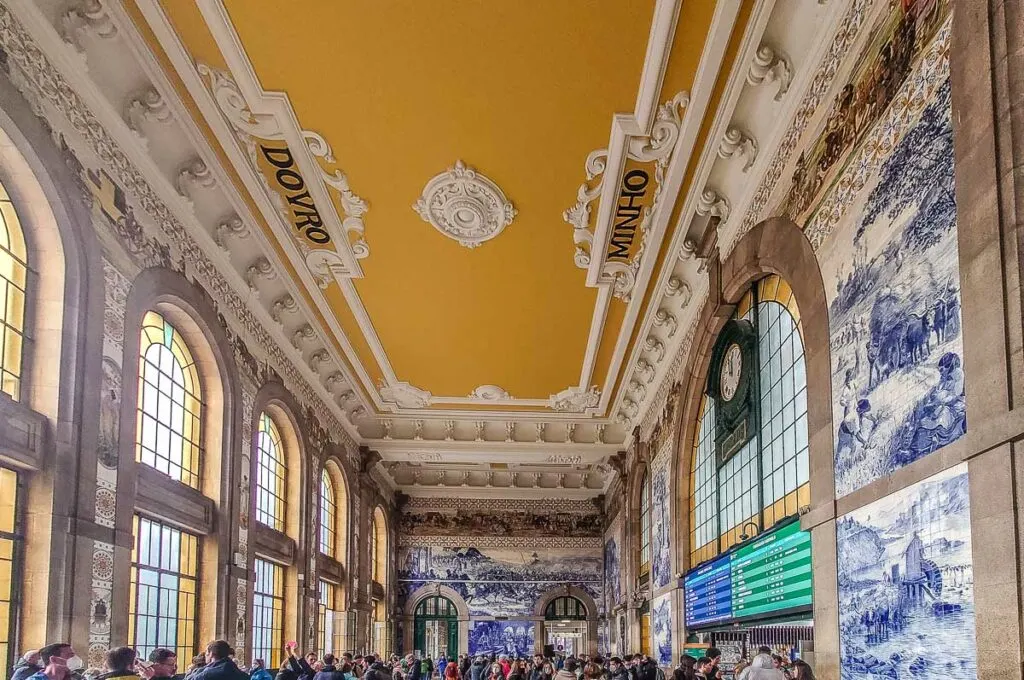
This one-day self-guided tour of the city of Porto in Portugal starts from the historic train station São Bento.
If you are arriving by car, there are many car parks around Porto, including right next to the train station. Pick the one that is most convenient for you. You can then start following the itinerary from the specific place you are at in town.
To make full use of your day in Porto, aim to begin this self-guided tour around 8.30 am. Especially, if you also want to grab a pastry or something else for breakfast first. Porto is rather large and you will want to see as much as possible for a truly memorable experience.
I haven’t assigned specific times of arrival and departure for each of the sights on this one-day itinerary for Porto. It is up to you to decide how much time you want to spend at each place and if you want to see them all or just a few.
Most of this self-guided tour of Porto is done on foot. Make sure that you wear comfortable shoes and clothing that will keep you either cool or warm depending on the season. For detailed walking directions turn by turn, please, refer to the map of this itinerary posted further down the page.
Ideally, spend a night in Porto – either before or after this one-day self-guided tour. This way, you will feel less rushed and will be able to catch a good night’s sleep to energise you for or after all the sightseeing. Alternatively, you can split this self-guided walking tour of Porto over two days.
São Bento Train Station – Estação de São Bento
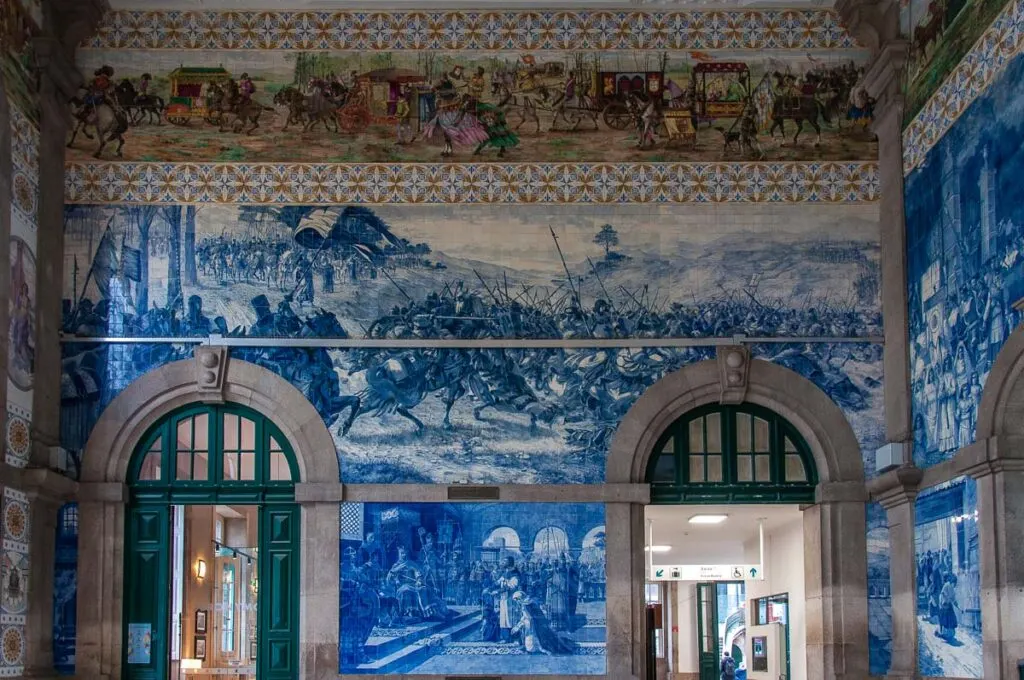
Porto’s 19th-century train station São Bento is an important railway hub. It stands on Praça de Almeida Garrett, right on the edge of Porto’s historic centre. It provides easy access to many of the city’s landmarks.
Most importantly, São Bento is also one of Porto’s main sights. Here you can see one of the most impressive azulejo cycles in Portugal. The vestibule of the station is covered with more than 20,000 azulejos. These are tin-glazed ceramic tiles which the Portuguese traditionally use to cover whole facades and interior walls, as well as to create decorative panels.
São Bento‘s azulejos were painted by the Portuguese artist Jorge Colaço from 1905 to 1916. The main panels of blue and white tiles depict important scenes of Portugal’s history. A smaller frieze of technicolour azulejos represents the evolution of the country’s transport.
Once you have had your fill of the beauty of São Bento‘s azulejos, it’s time to head to the next stop on our list – Porto’s Cathedral and Episcopal Palace. Both are right next to one another and about six minutes up the road from São Bento.
Porto’s Cathedral and Episcopal Palace – Sé do Porto and Paço Episcopal
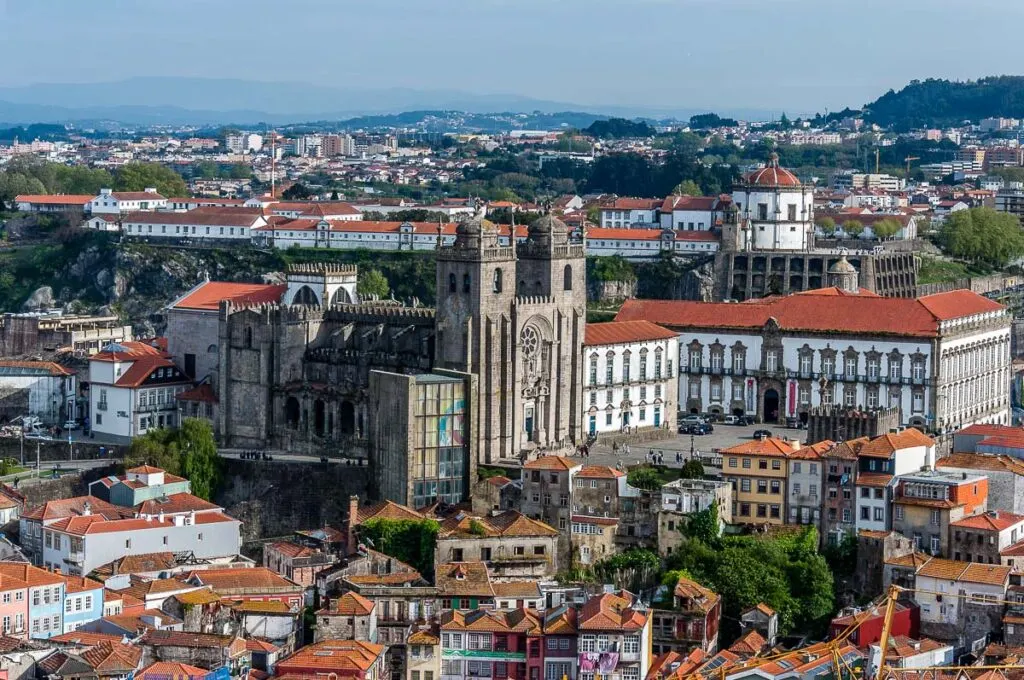
The city’s cathedral – known in Portuguese as Sé do Porto – is a majestic building which dates back to the 12th century. On the outside, it looks like a mix between a church and a fortress. Inside you can visit the cloister decorated with large azulejo panels, several lavishly adorned chapels, a sturdy tower, and the main church which has an imposing altar, towering pillars, a Romanesque choir, and bare stone walls.
Right next door to the Sé do Porto stands the Paço Episcopal. This is the former residence of the bishops of Porto and one of the most prominent buildings in the city. Inside, expect lavishly decorated rooms, a monumental staircase flanked by azulejo panels, and a lovely collection of paintings.
For the best price, you can buy a combined ticket for both the Cathedral and the palace. If you would rather skip the palace, then you can purchase a ticket for the Cathedral in advance online.
With their hilltop position, Porto’s Cathedral and Episcopal Palace command breathtaking views of the River Douro and the historic centre. These are best enjoyed from either the top-floor windows of the Episcopal Palace, the top of the Cathedral’s tower, or the Terreiro da Sé. The latter is the spacious half-square, half-terrace that protrudes in front of the cathedral and the palace.
It’s now time to head to the next stop on this one-day itinerary for the city of Porto in Portugal. The upper deck of the famous Ponte de Dom Luís I is only about three minutes away on foot from the Sé do Porto.
Dom Luís I Bridge – Ponte de Dom Luís I
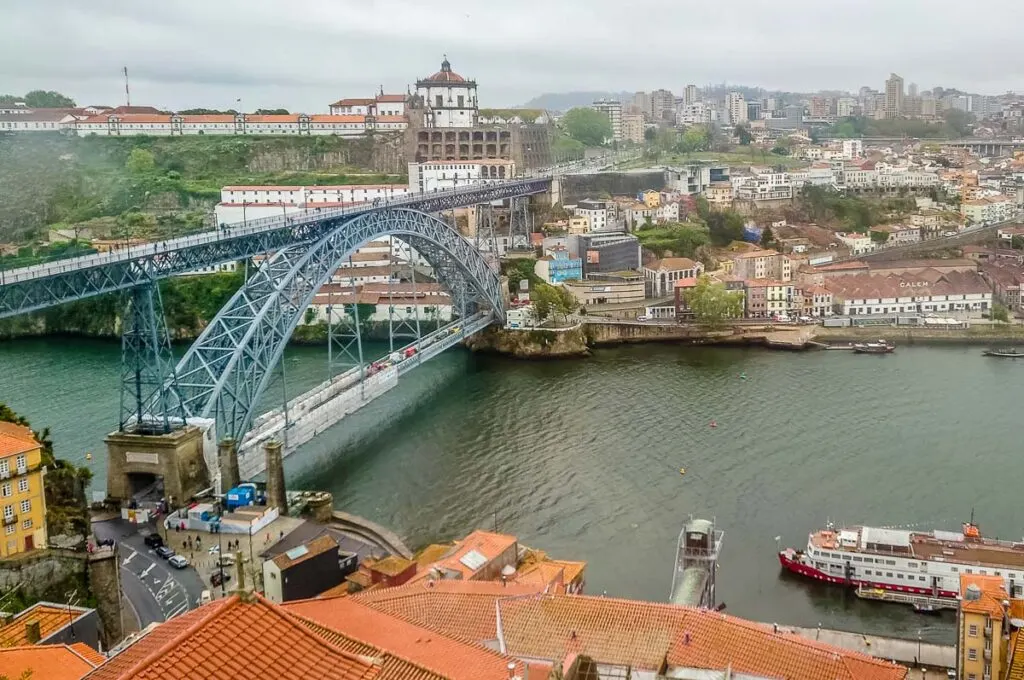
Ponte de Dom Luís I is one of the most beautiful bridges in the world. It was built by Théophile Seyrig – a German engineer and student of Gustave Eiffel (the designer of the world-famous Eiffel Tower in Paris).
The double-decker bridge is Porto’s pride and joy. It spans the River Douro at a picturesque meander and it links Portugal’s second-largest city to the city of Vila Nova de Gaia. The top deck is almost 400 m long. At 172 m, the lower deck is just under half its length.
The top deck of the bridge affords some of the most iconic views in the whole of Portugal. Walk along its full length to admire the striking panoramas of Porto and Vila Nova de Gaia. The two cities face each other across the River Douro.
The bridge’s top deck is open only for pedestrians and the electric trams of Porto Metro – the light rail network which connects the historic centre to the suburbs. The pedestrian paths run along the edges of the bridge and the trams take the central lane.
Many people walk all over the bridge to take photos and admire the views from both sides. However, bear in mind that trams seem to appear suddenly and are very quiet. You have to pay attention at all times, especially when it gets dark.
The next three steps on this one-day itinerary for Porto are optional. If they are not of interest to you, make your way to Cais da Ribeira to continue with this self-guided tour of Portugal’s second-largest city. Depending on your starting point on the upper deck of the bridge, it will take you between four and eight minutes.
Gaia Cable Car – Teleférico de Gaia (Optional)
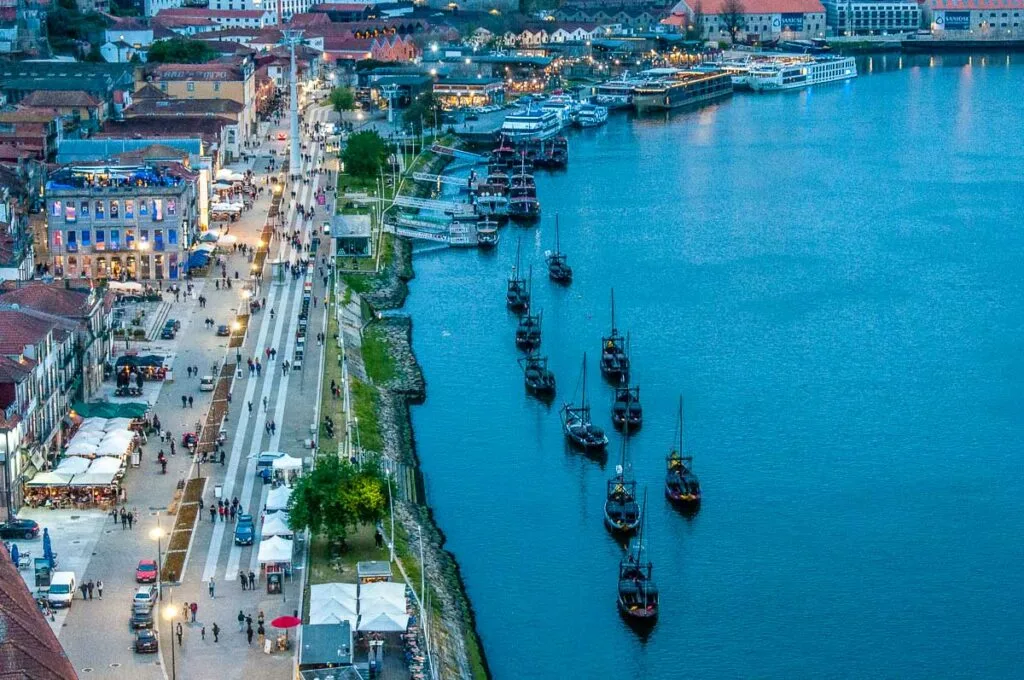
Walk along the full length of the upper deck of Ponte de Dom Luís I. At the Vila Nova de Gaia end, you will see the top station of the Teleférico de Gaia.
This is a cool cable car which swiftly takes you from the top level of the bridge down to the riverside. The short but exhilarating journey affords spectacular views over the river and the rooftops of Porto and Vila Nova de Gaia.
Once you reach the riverside station of the cable car, head to the next stop on this one-day itinerary of Porto – the cellars where the worldwide prized port wine spends years ageing.
Port Wine Cellars – Caves de Vinho do Porto (Optional)
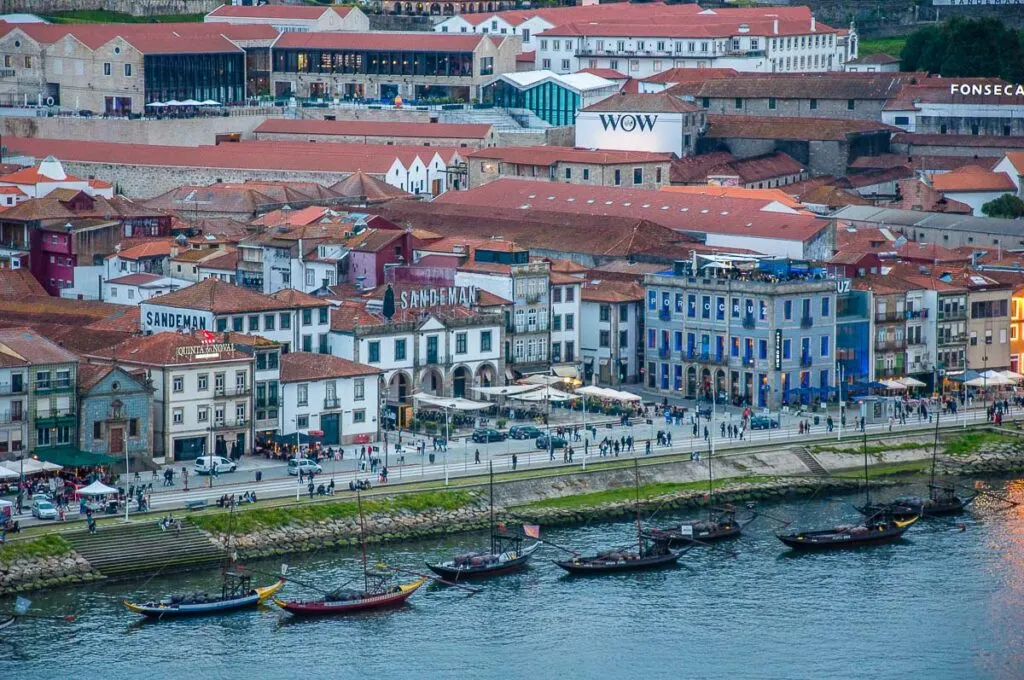
One of the most famous and prized types of wine in the world carries the name of the city of Porto. Port wine is a fortified wine, usually sweet and red, which has been produced in this corner of Portugal for centuries.
Nowadays, the local port wine traditions are zealously preserved. Many port wine cellars stand on the riverbank of the city of Vila Nova de Gaia in full view of Porto’s historic centre. Visiting a historic cellar to learn more about port wine and sample several of its varieties is one of the main things to do here.
The port-wine producers offer guided tours and tastings. You just need to decide which cellar to visit. My personal recommendations are for:
- Sandeman – an award-winning brand that has been producing port wines and sherry wines since 1790. Coincidentally, this was the first port wine cellar I visited in Porto many years ago. You will find it about four minutes away from the riverbank station of the Gaia Cable Car.
- Taylor’s Port – one of the oldest port wine houses in Porto. It’s been in operation since 1692. Its cellars are about eight minutes away on foot from the riverbank station of the Gaia Cable Car.
There are, however, many other port wine houses here. Pick the one that you feel appeals the most to your expectations. You can either book a visit through the website of the respective port wine producer or join a guided tour. This one, for example, will take you to the largest port cellar where you can see 6,518 casks of port wine. And this bestselling tour includes a visit to an interactive museum where you can learn about port wine through aromas, colours, and flavours.
Next, it’s time to return to Porto and explore its historic centre – a UNESCO World Heritage Site.
Across the River Douro (Optional)
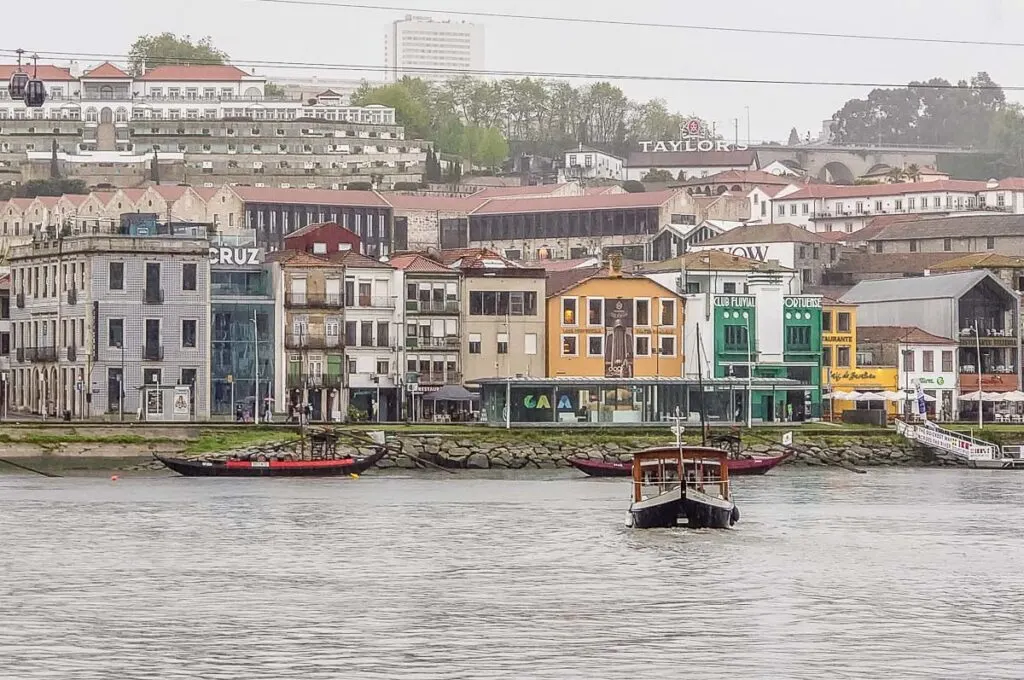
It’s time to head back to Porto’s historic centre. Climbing up the hillside that overlooks the mouth of the River Douro, this is a place where history has been made for over 2,000 years. This outstanding urban landscape was inscribed on UNESCO’s World Heritage List in 1996.
The easiest way to reach it is to take a Douro River Taxi after your visit to the port wine cellars in Vila Nova de Gaia. The river taxi is a boat called rabela. It leaves every 15 mins from the pier Cais de Gaia. It’s just a few minutes away from the Gaia Cable Car station.
The crossing takes five minutes, is inexpensive, and allows you to enjoy beautiful views of Porto and the River Douro. The boat will drop you off at Cais da Estiva. Once there, you can easily walk the short distance to Cais da Ribeira and begin your exploration of the historic heart of Portugal’s second-largest city.
Riverfront Promenade Cais da Ribeira and Historic District of Ribeira
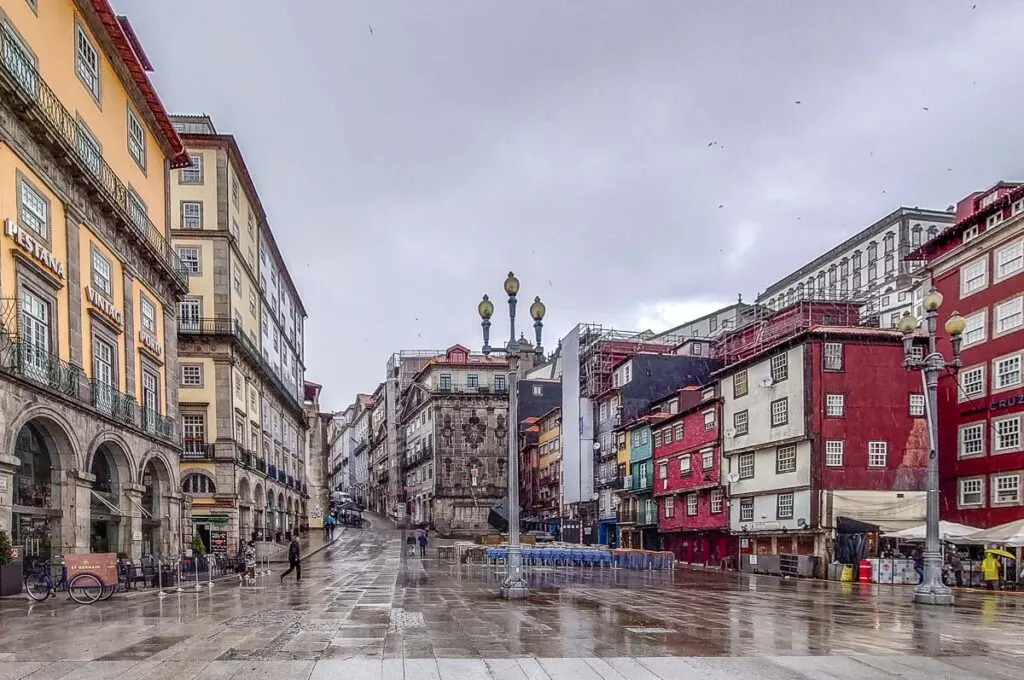
Cais da Ribeira is one of the most iconic places in Porto. This long riverfront promenade is flanked by numerous cafes, bars, and restaurants. Above them tower Porto’s historic multi-storey buildings. The facades of many of them are covered with azulejos thus creating pleasing blocks of colour.
Between the tall houses turn and curve dozens of steep narrow alleys and streets. Many of them have flights of steps instead of smooth pavements and are impassable for cars. Freshly-laundered clothes flap in the air above your head. Wrought-iron balconies adorn the tall facades. Buildings – both derelict and lovingly restored – stand shoulder to shoulder, supporting each other as the decades and centuries glide past.
This is Ribeira – Porto’s medieval nucleus. A place where you can observe the city at its rawest and most authentic. Don’t miss Praça da Ribeira – an expansive central square that in the evening becomes Porto’s liveliest meeting point. Restaurants place their tables outside thus turning the praça into a theatrical auditorium where you sit and observe real life as it happens.
It is from Cais da Ribeira that you can take the next step on this one-day itinerary for Porto: the optional Six Bridges River Cruise followed by a visit to some of Porto’s most important sights. Let’s go!
Six Bridges River Cruise (Optional)
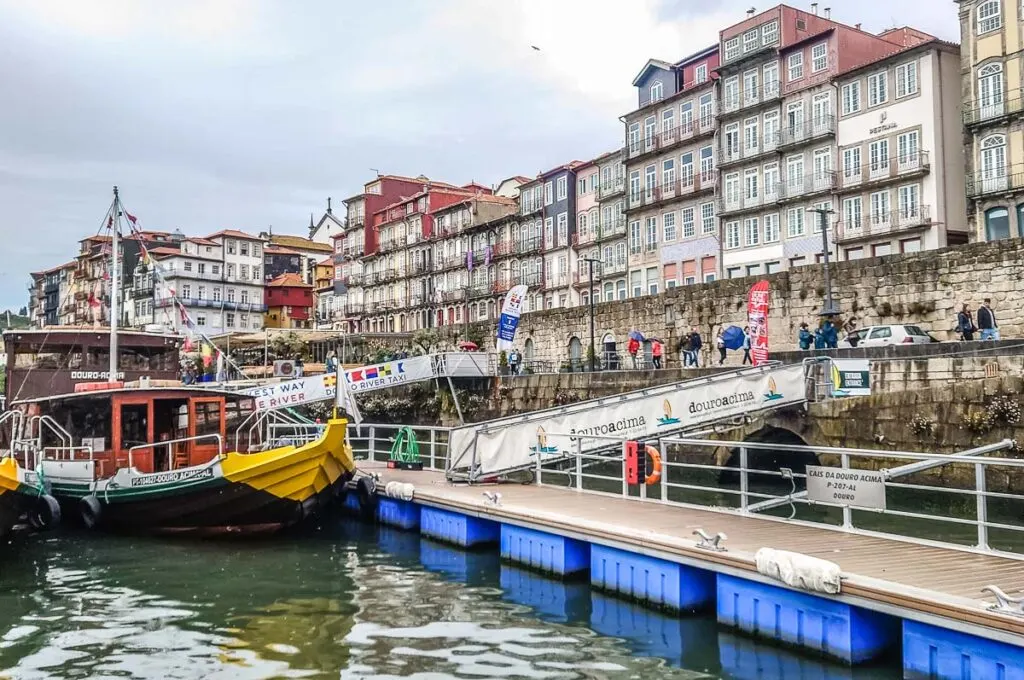
The Six Bridges River Cruise is one of the most popular things to do in Porto. It’s a boat tour taking in the six impressive bridges that connect the steep hillsides on both sides of the River Douro. The tour affords fantastic panoramic views of Porto and the river’s mouth. You even get to see where the river flows into the Atlantic Ocean.
The boats used for the tour are known as rabello in Portuguese. They are traditional for the area boats which in the past transported wine barrels down the river. The tours leave from either Cais da Ribeira or Cais da Estiva. They take about 45-50 mins.
If you have spent the morning visiting the port wine cellars and have then taken the Douro River Taxi across to Porto’s historic centre, it may feel a bit redundant to do the Six Bridges River Cruise, too. Instead, you may want to dedicate the rest of your time here to the major Porto sights covered under the next steps of this one-day itinerary. So, I am leaving it to you to decide how you want to proceed.
In any case, I did enjoy quite a lot the Six Bridges River Cruise. It was really lovely to see the city from the water.
City Museum – Prince’s House – Museu da Cidade – Casa do Infante (Optional)
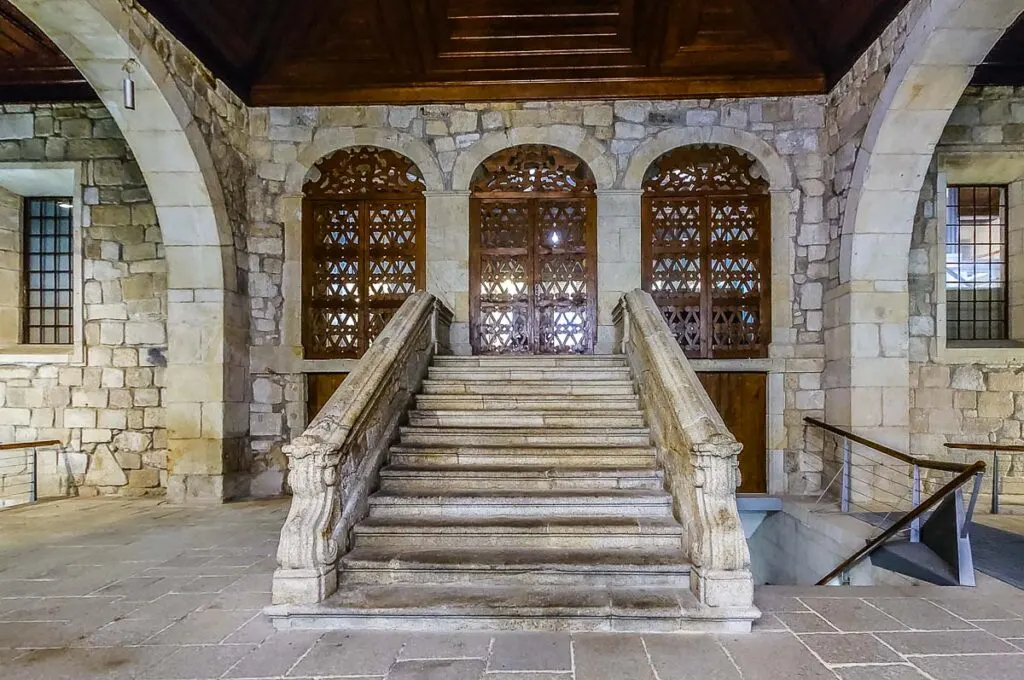
Next, let’s head to the Museu da Cidade – Casa do Infante. This is an often-overlooked sight in Porto. If you have a particular interest in the Middle Ages and the Portuguese maritime discoveries, pencil in half an hour or so for a visit here.
The Museu da Cidade – Casa do Infante is about 4 mins away on foot from Cais da Ribeira and only a minute up the road from Cais da Estiva. This is one of the oldest buildings in Porto. It was first built in the 14th century on top of the ruins of a Roman villa. It was then extensively remodelled in the 17th century.
For many hundreds of years, Porto’s customs and mint were housed here. With boatloads of goods reaching Porto via the River Douro and the Atlantic Ocean, this was one of the city’s busiest and most important places in terms of finances and taxation.
Curiously, Prince Henry the Navigator was born here in 1394. He was instrumental in the creation of the Portuguese Empire and its maritime explorations. Nowadays, the former customs house is known as Casa do Infante – the House of the Prince – and it functions as one of the branches of Porto’s city museum.
It is a well-curated space where you can see restored Roman mosaics and learn more about Porto and its financial heyday during the Late Middle Ages. There is also quite a lot of information about Portugal’s maritime expeditions.
Next, let’s head to the Church of São Francisco just across the road.
Church of St. Francis and Catacombs – Igreja de São Francisco e Catacumbas
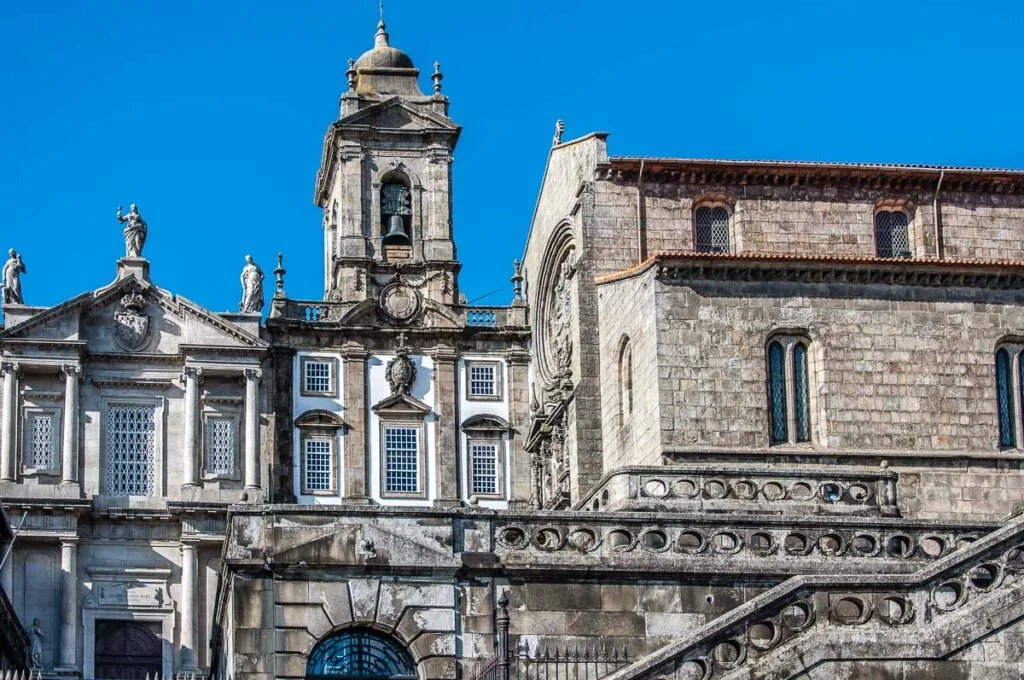
The Igreja de São Francisco is Porto’s most outstanding Gothic building. Plus, inside it, you can see some of the most opulent Baroque interiors in the whole of Portugal. You will find the church 2 mins away from the Museu da Cidade – Casa do Infante and 6 mins away from the Cais da Ribeira.
While the Igreja de São Francisco is one of the most expensive sights to see in Porto, a visit to it is a must on account of two things:
- the incredibly rich Baroque ornamentation of the church’s chapels and altar. It’s been calculated that the florid wood carvings here have been gilded with close to half a ton of gold dust (different sources quote between 300 and 600 kg).
- the church’s catacombs where both Franciscan monks and members of Porto’s richest families are laid to rest. Interestingly, in one of the chambers of the catacombs, there is a hole in the floor which is covered with a thick pane of glass. Look through it and you will see a large pile of human bones. It’s a bit macabre but not really scary as the place itself feels very calm and safe.
In front of the Church of São Francisco, you can also see the end stop of Porto’s historic trams. They look great in photos but be aware when you cross their tracks as the trams move fast and often very close to some of the buildings along the way.
Now, it’s time to head to another one of Porto’s major sights – the Palácio da Bolsa. It’s only round the corner from the Church of São Francisco, a minute or so away on foot.
Bolsa Palace – Palácio da Bolsa
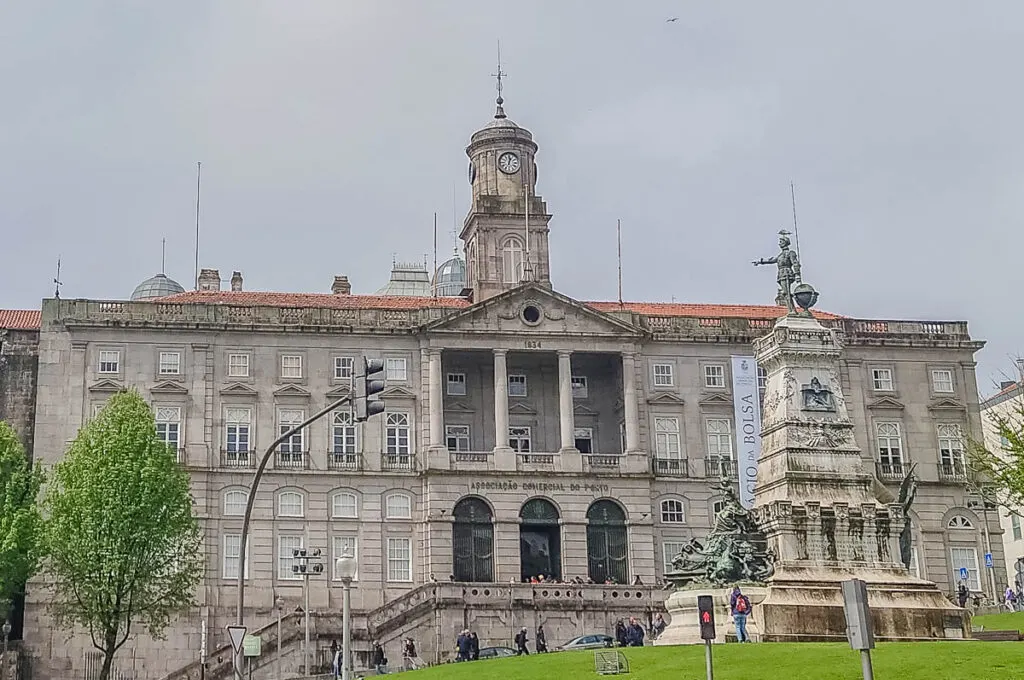
The Palácio da Bolsa is a lavish 19th-century palace in the Neoclassical style. It faces the Praça do Infante D. Henrique in the centre of which stands an impressive monument of Prince Henry the Navigator.
The palace was built by Porto’s Commercial Association to serve as a stock exchange. The imposing building has a series of sumptuous rooms with the Arab Room the most splendid of them all.
You can buy a ticket for Palácio da Bolsa either from the official website or GetYourGuide. The palace can only be visited as part of a guided tour. So, even if you have a ticket bought in advance, you still need to queue on the day in order to get a space on a guided tour. The tours last around 30 mins and are held in one of four languages – Portuguese, Spanish, French, and English.
There are always queues here. Even more so on Mondays when most other sights around Porto are closed. Palácio da Bolsa is the most visited landmark in the north of Portugal. If you want to see it, you need to be prepared to queue and you may need to forego other sights on this one-day itinerary of Porto.
Next, get ready for a bit of a steep walk which will be generously rewarded with even more beautiful views of the city of Porto.
Vitória Viewpoint – Miradouro da Vitória
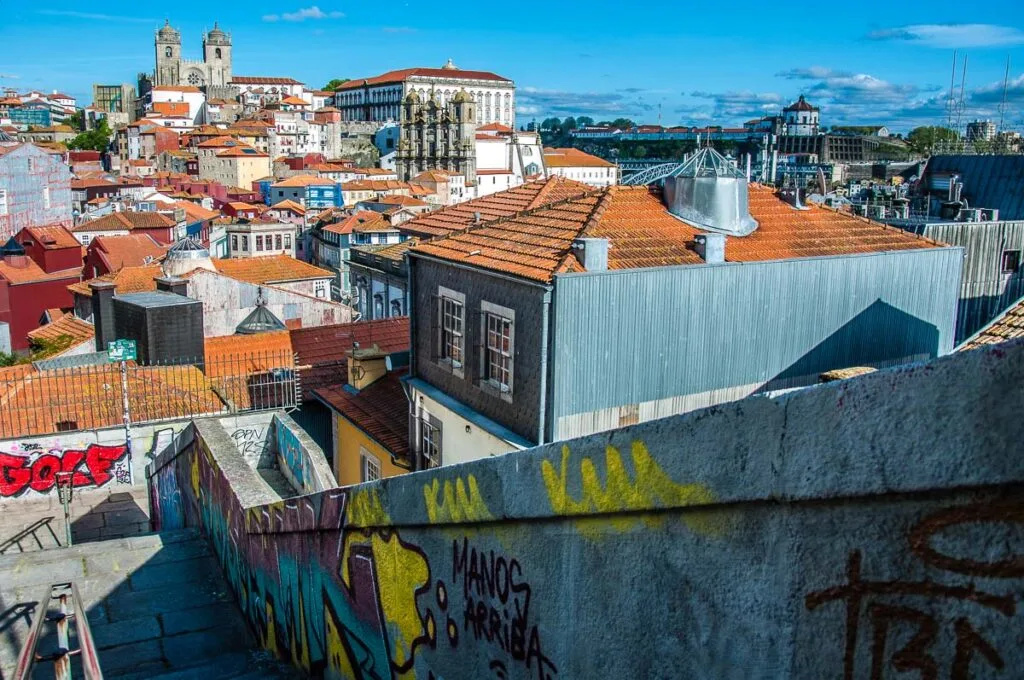
The Miradouro da Vitória is a spacious, free-to-access terrace in the heart of the historic centre. It affords beautiful views over Porto, the River Douro, and the city of Vila Nova de Gaia on the opposite bank.
It takes about 6 mins to reach the miradouro from the Palácio da Bolsa. Streets here get quite steep. At a few points along the way, flights of steps connect the different alleyways. While by now you may feel a bit tired, it’s a very picturesque walk allowing you to explore hidden corners of Porto.
Buildings here may appear a bit dilapidated and streets may be a bit dusty. Yet, it’s all part of exploring the city in the most authentic way.
Take a bit of time at the Miradouro da Vitória to catch your breath and take in the views. The red rooftops of Porto cascade down the steep hillside all the way to the sparkling waters of the river. Porto’s Cathedral and Episcopal Palace preside above them all. Behind them, peaks the arch of the Dom Luís I Bridge.
Just by the entrance to the miradouro you may see a series of small cat houses. They have been set up by the locals for the kitties which reside in the area. This make the place even quainter.
More stunning views of Porto and one very interesting church are on the menu next. Head to Torre dos Clérigos – Portugal’s tallest bell tower. It’s only 4 mins away up the street from the Miradouro da Vitória.
Clérigos Tower – Torre dos Clérigos
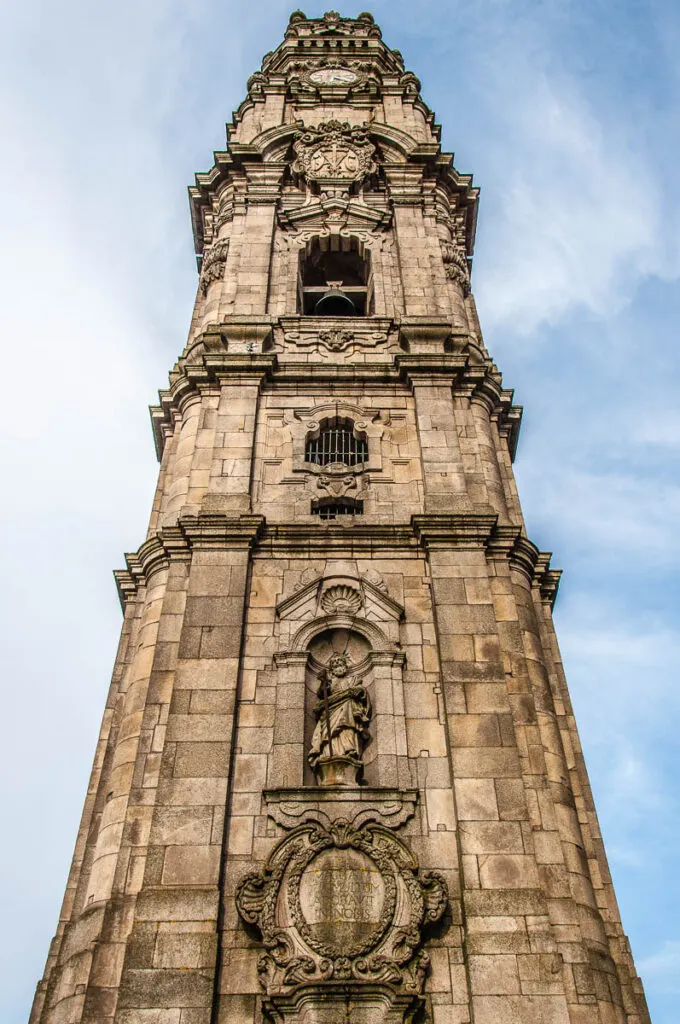
Torre dos Clérigos is the 75-m tall bell tower of the Igreja dos Clérigos. This is an iconic church in Porto which was designed by Nicolau Nasoni. He was an 18th-century Italian artist and architect who gave Porto some of its most splendid Baroque works of art and buildings.
You can enjoy the best panoramas of Porto from the narrow balcony that circles the summit of Torre dos Clérigos. The effort of climbing its 240 steps is definitely worth it. You can book your ticket(s) in advance (recommended during the high season) or buy them on-site. The entry price includes a visit to the actual church and its collection of religious art and relics.
At the full hour, the bells of the Clérigos Tower ring a beautiful tune. You can see them as well as the mechanism which controls them is behind a thick glass pane halfway up the steps as you climb the tower. Standing there and listening to the song of the bells is a really cool experience. Unless, of course, you find loud noises unbearable.
After you take your last panoramic view of Porto, head to the last stop on this one-day itinerary for Portugal’s second-largest city. The historic Livraria Lello is just 3 mins up the road from the Clérigos Tower.
Lello Bookstore – Livraria Lello
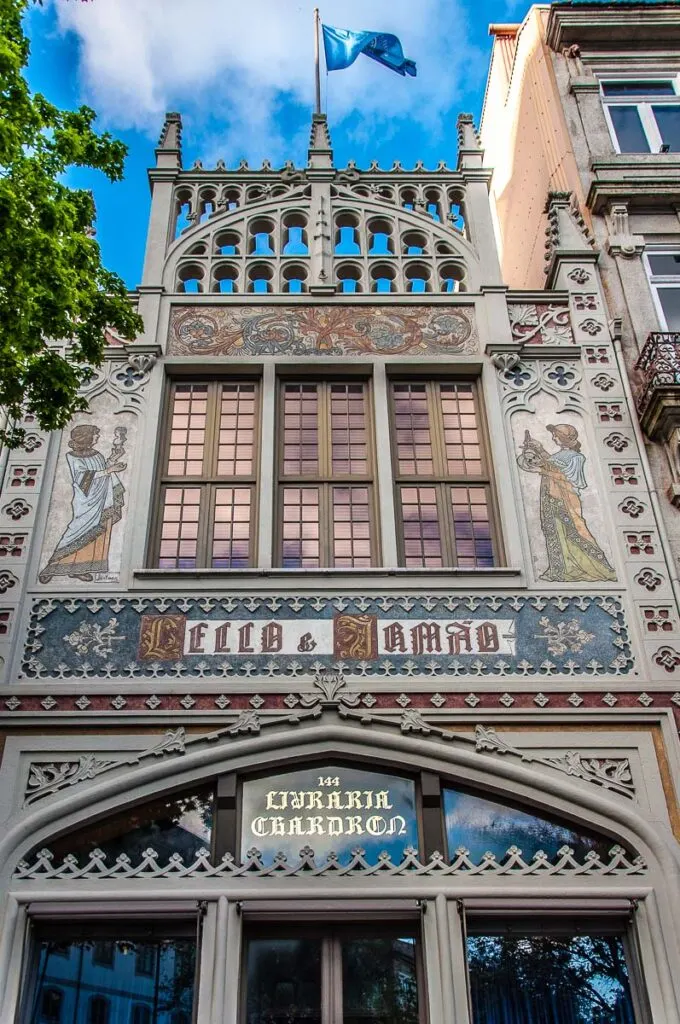
Let’s finish our day in Porto with a visit to the most beautiful bookstore in the world. Livraria Lello has a striking Neo-Gothic facade, a mesmerisingly twisted red staircase, huge stained glass panels, and intricate wood carvings. Plus, it sells books in several different languages that are beautifully printed and illustrated by its own publishing house.
Above all, Livraria Lello is famous as the bookstore often visited by the famous author J.K. Rawling when she lived in Porto. Allegedly, the descriptions of Hogwarts and its magical stairs in the Harry Potter books were inspired by the interiors of the livraria.
Nowadays, the bookstore has become one of Porto’s major sights. Every day, a long queue snakes in front of it and people need to buy a ticket in advance from the official website and then wait to be let in. Towards the end of the day, the queue tends to almost dissipate. So, make sure that you are in front of Livraria Lello about 40 to 60 mins before it closes.
Once inside and with the last tourists for the day slowly tricking out, you will have a few precious moments to explore the bookstore without the huge crowds that besiege it throughout the day.
End of this One-Day Itinerary for Porto, Portugal
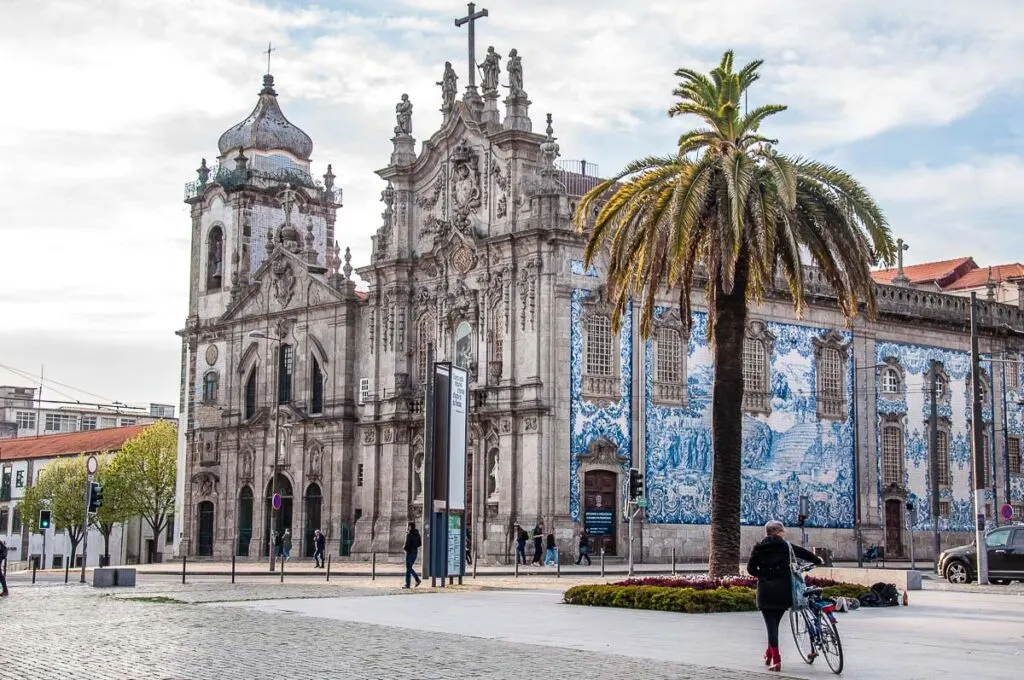
It’s been one very busy, hectic day sightseeing around Porto. I hope that you enjoyed it and that you got to see and experience lots of beautiful and wonderful things.
‘Where next?’, you may ask. It depends on how much time you’ve got left and what your plans are. If you still have an hour to spare, then head up the road from Livraria Lello to see the beautiful Igreja do Carmo and its azulejo panels. It’s only 2 mins away.
You can also walk to Avenida dos Aliados – around 7-8 mins away – to see the grandiose buildings that flank Porto’s main avenue. Then continue for 5 mins to the historic Café Majestic – a triumph of Art Nouveau. You will find the cafe on Porto’s main shopping street – Rua de Santa Caterina.
On the way there, you will also walk past Porto’s covered market – Mercado do Bolhão – and one of the prettiest delis in all of Europe – A Pérola do Bolhão.
Alternatively, head straight back to your accommodation in the city or if your time in Porto has come to an end, walk back to the São Bento train station. It’s only about 5 mins or so away from Livraria Lello.
Map of This One-Day Itinerary for Porto, Portugal
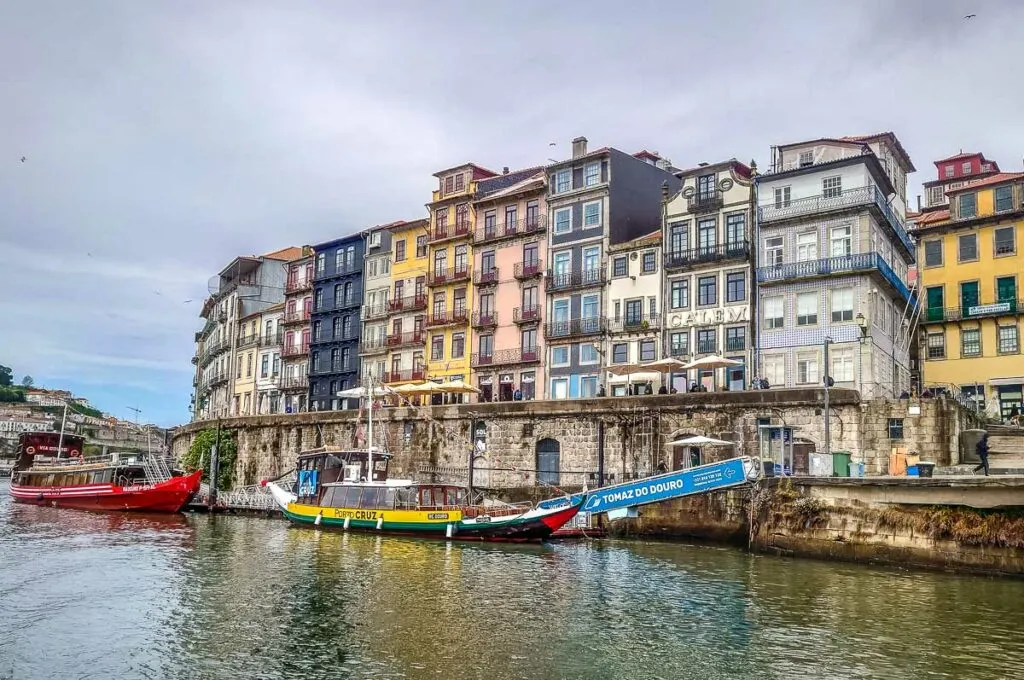
Here is a map showing you the sights and landmarks to explore during your day trip to Porto in Northern Portugal.
I made it using Google Maps. So, you can use it just like any other Google map. You can zoom in and out, click to open the map in a separate tab, and click on the different pins to see their coordinates and pertinent information.
You can also use this map to calculate distances and directions from any of the featured sights and landmarks to any other point in Porto. This way you can make your own itinerary to follow in Portugal’s second-largest city.
If you want, you can also share this map on social media, too.
The sights and landmarks pinned to this map are as follows:
1. São Bento Train Station 2. Sé do Porto 3. Paço Episcopal 4. Terreiro da Sé 5. Ponte de Dom Luís I 6. Teleférico de Gaia (Station Jardim do Morro) 7. Teleférico de Gaia (Station Cais de Gaia) 8. Sandeman 9. Taylor’s Port 10. Cais da Estiva 11. Cais da Ribeira 12. Praça da Ribeira 13. Museu da Cidade – Casa do Infante 14. Igreja de São Francisco e Catacumbas 15. Palácio da Bolsa 16. Miradouro da Vitória 17. Torre dos Clérigos 18. Livraria Lello
What to Eat in Porto in Northern Portugal
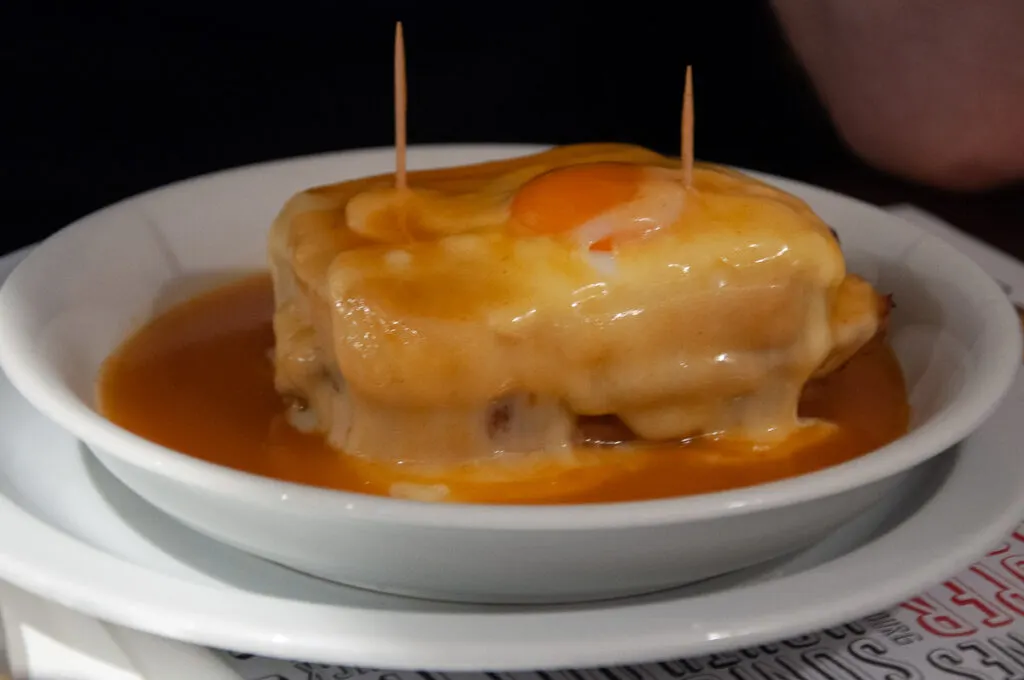
As this one-day itinerary of Porto is packed full of visits to sights and unique experiences, there is not much time left for lengthy meals. Depending on your approach to food, you can either pick light snacks and finger foods as you sightsee around Porto or clear out a portion of the day for a sit-down meal.
Around the historic centre, there are many small cafes and eateries. You can grab a quick pastry to have on the go or one of the typical for Porto sandwiches – francesinha, cachorrinho, and bifana – to have for lunch.
A francesinha is a sandwich that is stuffed with several different types and cuts of meat. It’s then topped with cheese (and sometimes with a fried egg), and it’s served doused in a hot peppery sauce made of tomatoes and beer. Often, it comes with a large helping of chips, too.
A cachorrinho is Porto’s take on the classic hotdog. Expect so much more than a sausage in a bun though. Crusty bread, delicious cheese, a proper sausage, and even vegetarian options.
A bifana is a traditional Portuguese sandwich stuffed with thin slices of pork and served on a soft bread roll. The pork is marinated and then simmered in a sauce made of white wine, garlic, and paprika.
You can also snack on rissóis. These are small croquettes with one of several different fillings – beef, chicken, and even tuna fish and prawns. Or you can grab a lanche – a pastry stuffed with cheese, ham or spicy pork sausage called chouriço.
For a bit of warmth on a cold day, opt for a bowl of caldo verde. This is typical for Portugal soup of potatoes, kale, and thinly sliced sausage. Then, you will have plenty of space left to also tuck into a Portuguese sweet or dessert.
If you would rather enjoy a sit-down meal, O Comercial – the restaurant in the Bolsa Palace – is an elegant choice. From Tuesday to Friday, it also serves a set lunch menu allowing you to taste traditional and innovative meals at a very affordable price.
For more information about Porto and food, have a look at the heading ‘9 Photos of Porto’s Delicious Food’ in this blog post:
What to Buy for your Visit to Porto
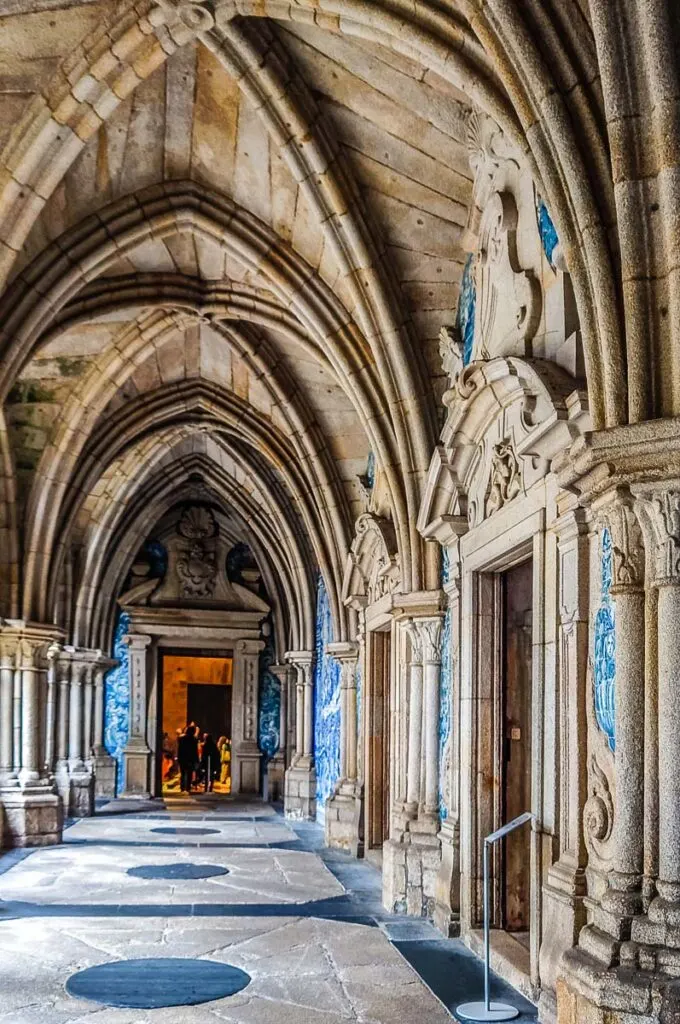
Here are a few items that may come in very handy for your visit to Porto in Northern Portugal:
Porto Card – offering a long list of discounts and free entry to a number of selected sights, this is a useful card to have during a visit to Portugal’s second-largest city. There are two options and each option is valid from one to four days:
- Porto Card Walker – if you are not planning to use any public transport during your stay in Porto.
- Porto Card with Transportation – allowing you to use the city’s public transport for free.
Portable Charger – With all the beautiful views and must-see sights that Porto has to offer, you will want to keep your mobile phone charged at all times to capture it all in photos and videos.
Smart Trackers – always good to have them attached to wallets, cameras, and even pets and kids for peace of mind when travelling.
Passport Cover – as a visitor to Portugal, you need to carry an identification document with you when out and about. This is explained succinctly here. Keep your passport wrinkle-free in this very stylish passport cover. Alternatively, pick this one which comes in a selection of colours to appeal to any taste.
What to Buy during Your Visit to Porto
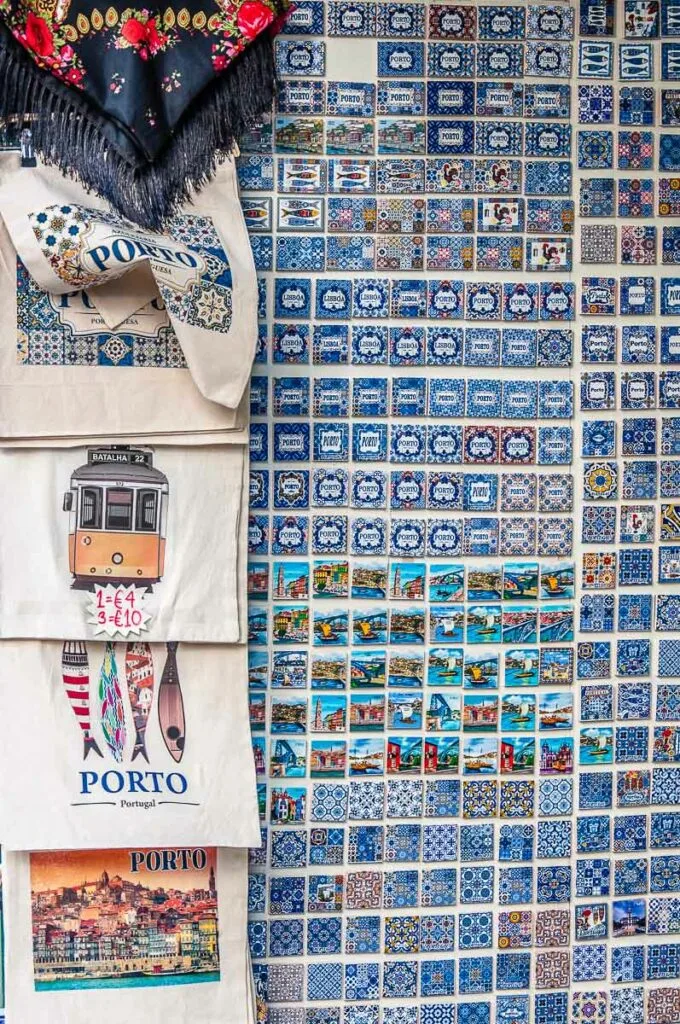
From fridge magnets to rare port wine, Porto is a great place to shop. Here is a shortlist of some exciting goodies to get your hands on when in town:
Cork products – Portugal is the world leader in cork production. Expect to see this natural organic material fashioned into a huge variety of products – from postcards and pens to bags and hats.
Anything port wine – from bottles of vintage port to port wine glasses and decanters.
Artisanal chocolates and dragees – stock on exquisite sweets that are made in Porto. Especially well-known and beautifully presented are the drageias de licor Bonjour. Read more about them under point 5 in this blog post: 25 Delicious Portuguese Desserts and Pastries.
Handcrafted soaps – Porto seems to have the best selection of artisanal soaps I have come across. They have wonderful scents, lather beautifully, and last a long time.
Canned fish and seafood – canned sardines, cod, tuna fish, octopus, squid, and mackerel are a must-try in Portugal. You will find a great selection in Porto’s delis. A Pérola do Bolhão is one of the best.
Gold filigree jewellery – typical for Portugal, this ornamental openwork is fashioned into delicate and beautiful earrings and pendants. The so-called Viana Heart (Coração De Viana) is the most popular traditional motif.
Practical Tips about Taking a Day Trip to Porto in Portugal
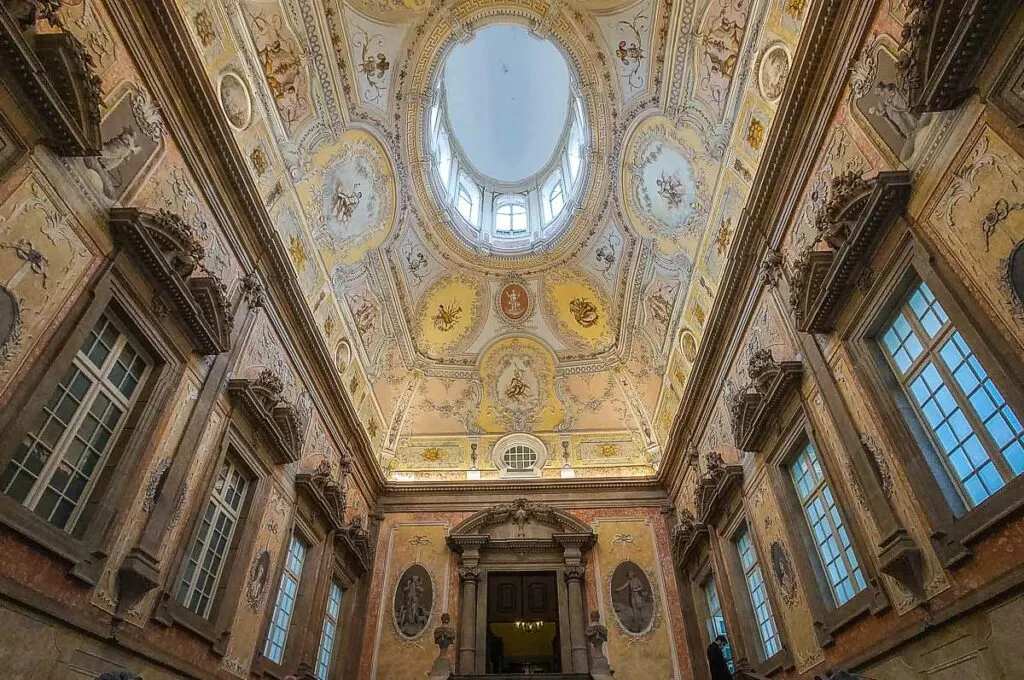
Porto is a must-see city in Northern Portugal in particular and Europe as a whole. It’s rich in sights and things to do. It has a vibrant energy, delicious local cuisine, and amazing panoramic views. Plus, it’s very photogenic!
While a day is not really enough to cover everything that Porto has to offer, if you are in the area and a day is all you can spare, then a visit to Porto is a must. It’s just the right amount of time to get acquainted with the city, tick off some of its major landmarks, and find out if you want to return for a longer stay.
So, to make your day trip to Porto in Portugal as exciting and smooth as possible, keep in mind the following practical tips:
Manage your expectations – accept that you won’t be able to see it all and do it all in a day in Porto. Rushing around and trying to see as much as possible from morning til dusk will leave you overwhelmed and won’t let you enjoy the city properly.
Instead, choose a few sights you really want to see and a couple of experiences you really want to have and stick to them. The one-day itinerary I shared with you in this blog post gives you a great initial overview of Porto.
Order of sightseeing – feel free to adapt this one-day itinerary for Porto in Portugal to your specific needs. For example, you may decide to add more stops along the way, change the sequence of sights visited or even omit certain landmarks which may not be of interest to you.
Plus, you can easily split this self-guided walking tour of Porto over two days. This way you can spend the night in this exciting Portuguese city, eat a delicious dinner of fresh seafood, and enjoy Porto’s vibe in the evenings when the locals come out for a walk, meet up with friends, and relax after a long day.
Expect queues – Porto is a very popular tourist destination. Queues are a fact of life for the main landmarks here. Especially, during the high season.
To save a bit of time, you can buy tickets in advance for the things you want to see. Yet, in the case of the Palácio da Bolsa, for example, this still is not a guarantee that you won’t have to queue.
Distances and walking times – Porto is very walkable. However, it’s still a large city with an expansive historic centre. If you decide to follow this one-day itinerary stop by stop, then prepare for a day of active walking, often uphill.
There is something to see and do at every step here. So, walking doesn’t feel tedious and time flies quickly. Distances between the different sights may vary from one minute to 10-15 minutes or so.
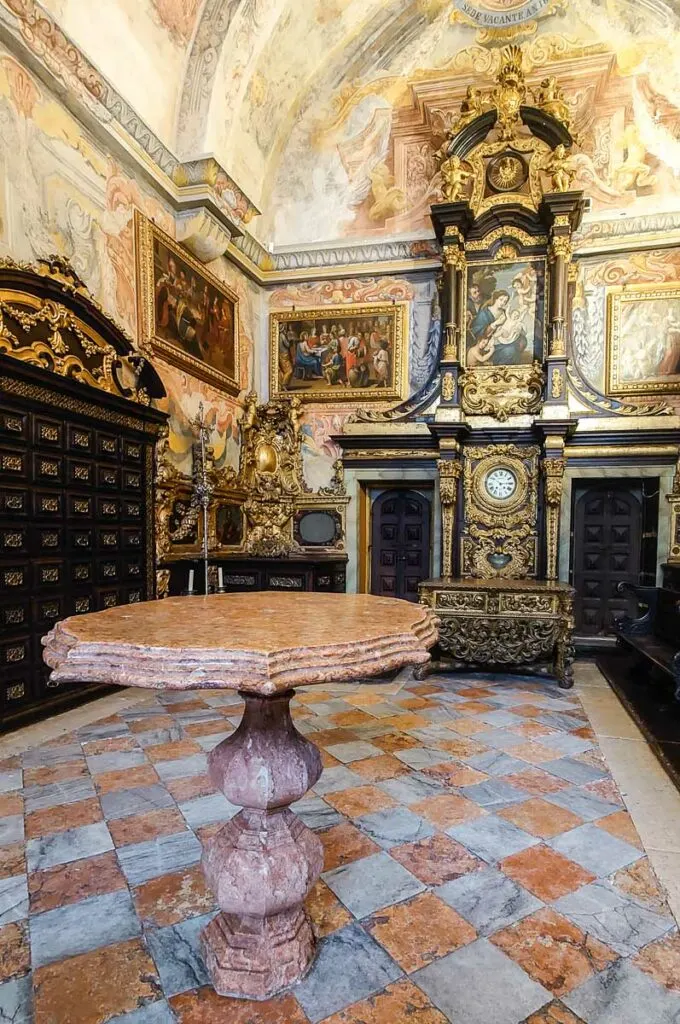
Historic surfaces – many streets and squares here are covered with a particular type of cobble called calçada portuguesa. This is a mosaic-like pavement made of small cobbles.
Other streets in Porto are paved with stone slabs. Plus, in the historic centre, you may come across flights of steep steps connecting the different alleyways.
Ideally, wear appropriate shoes that support the ankles, have a good grip, and when it’s hot, don’t allow your feet to slide inside them.
Energy levels and skincare – keep hydrated and sated at all times, especially on a hot sunny day. Bring a water bottle (or get one from a shop in town), feast on the local delicacies, and stay out of the sun during the hottest hours of the day.
Visiting with kids – Porto may be an exciting city for teenagers and pre-teens. There are cool foods to try, picturesque views to enjoy, exciting stories to learn about, and some unusual sights to visit along the way.
If you are travelling with babies and toddlers, consider bringing a carrier like an Ergobaby or similar with you. The pavements in the historic centre are often small, narrow, and uphill. This makes using a stroller a bit more difficult.
Opening times – always check current opening times before your visit. Where possible, I have provided links to the official websites of the different sights in Porto.
Keep in mind that many of the city’s main sights are closed on Mondays.
Organised tours – if you don’t feel like travelling on your own and doing it all by yourself, then you can book a guided tour. There are many tours to enjoy in Porto. Some take in all of the local highlights. Others introduce you to certain major sights or particular facets of the city.
This walking tour is particularly good if you want to see Porto’s historic centre in the company of other travellers from all over the world. This bestselling tour combines the convenience of a hop-on hop-off bus with a river cruise and a port cellar visit.
This one is a great highlights tour by tuk-tuk – a cute way to navigate Porto’s maze of old streets. Finally, this private tour will introduce you to the delights of Porto’s cuisine through ten outstanding tastings.
How to Reach Porto by Plane, Train, Bus or Car
Pin for Later!

It is very straightforward to reach the city of Porto from anywhere in Portugal and Europe either by plane, train, bus or car.
Here is how to proceed:
By Plane:
A large number of national and low-cost airlines operate regular flights to Porto from all across Europe and the world. Average flight times are as follows:
London to Porto – 2 h 22 mins
Paris to Porto – 2 h 12 mins
Madrid to Porto – 1 h 15 mins
Rome to Porto – 2 h 55 mins
Berlin to Porto – 3 h 30 mins
Porto Airport (OPO) is small, tidy, and very easy to navigate. It stands on the outskirts of the city and is connected to the city centre by bus, metro, taxi, and private transfer. If you purchase the Porto Card with Transportation, then you can use the public transport in Porto for free for the duration of the card – from one to four days.
We booked our accommodation through Booking.com and it came with the added benefit of a free private transfer from the airport. We booked the same driver to take us back to the airport after our week in Porto came to an end. It cost us 25 euros and it was money well-spent considering the early flight and the torrential rain that was beating down at three o’clock in the morning.
By Car:
Use Google Maps or an alternative GPS app to get specific directions from your point of departure to the city of Porto in Northern Portugal.
Here are some average travelling times to give you an idea of how long it will take you to drive to Porto from some of the most important Portuguese cities:
from Guimarães – from 45 mins to 1 h 15 mins, 57 km away;
from Braga – from 45 mins to 1 h 20 mins, 58 km away;
from Aveiro – from 45 mins to 1 h 5 mins, 75 km away;
from Coimbra – from 1 h 15 mins to 2 h, 122 km away;
from Lisbon – from 2 h 40 mins to 4 h, 314 km away.
Be aware that Porto can be quite difficult to navigate by car on account of heavy traffic and narrow streets in the historic centre.
Unfortunately, we heard a lot of first-hand stories about car theft in Porto. We had wanted to rent a car for day trips from Porto. It turned out that the small family hotel we had booked didn’t have a car park. Then the owner advised us that the rental car had to be left at a special paid-for covered car park some distance from the hotel.
All this discouraged us from renting a car while in the city. We found taxis very affordable, public transport well-organised, and the central part of Porto very easy to navigate on foot.
By Train:
Portugal has a well-organised railway system operated by the national train company Comboios de Portugal. Trains running at regular intervals throughout the day connect Porto to the country’s other large cities and many hidden gems. You can use the train company’s website to check travel times and buy tickets in advance.
You can also buy tickets at the train station. Remember to validate your ticket before boarding the train.
Guimarães to Porto – trains from Guimarães stop at Porto’s Campanhã station and then proceed to Porto’s São Bento station. The journey lasts about 1 h 12 mins or slightly longer depending on the time of the day. It’s quite tedious as the train stops at over 20 small towns along the way. Yet, the tickets are very inexpensive and it’s a very easy day trip to make. You can check the timetable at this link.
There is also a shuttle bus connecting the city of Guimarães directly to Porto Airport. You can check the current timetable of the airport shuttle bus at this link.
Braga to Porto – trains from Braga stop at Porto’s Campanhã station and then proceed to Porto’s São Bento station. The journey lasts either 54 mins or 71 mins depending on the number of stops along the way. It’s quite a tedious journey as the train stops at numerous small towns but it’s very inexpensive and very easy to make. You can check the timetable at this link.
Aveiro to Porto – trains from Aveiro stop at Porto’s Campanhã station and then most proceed to Porto’s São Bento station. The journey lasts about 1 h 18 mins or slightly longer depending on the time of the day. It’s quite tedious as the train stops at over 20 small towns along the way. Yet, the tickets are very inexpensive and it’s a very easy day trip to make. You can check the timetable at this link.
There is also a high-speed train connecting Aveiro to Porto. The tickets for it, however, cost from four to six times more and the time saved is only about 20 mins or so.
N.B.: When you board the train to Porto from either Guimarães, Braga or Aveiro, try to sit on the left-hand side of the carriage. This way, upon reaching Porto, you will see the meanders of the River Douro and some of the bridges which span the hillsides that flank the river’s mouth.
If you travel from Aveiro, this will also allow you to enjoy the views of the Atlantic Ocean as for a part of the journey, the railway line runs parallel to the beaches.
Bear in mind that Guimarães, Braga or Aveiro to Porto are popular train journeys. Trains get full fast, especially on weekends. Try to be at the train station at least 10 mins before departure. When we travelled between Guimarães, Braga, Aveiro, and Porto in April of this year, the trains were full both ways and there were people standing up for some or most of the journey.
Lisbon / Coimbra to Aveiro – trains leave from Lisboa Santa Apolónia and also stop at Lisboa Oriente train stations. They take on average 3 h to 3 h 30 mins to reach Porto’s Campanhã station. Once there, you can get an urban train for the short journey to Porto’s São Bento station. Alternatively, you can get a bus or a taxi.
Coimbra is a stop on the same railway line.
By Bus:
You can reach Porto also by bus. In general, tickets are more expensive than getting there by train, although monthly deals and discounts can be available. Also, travel times are sometimes longer.
You can use the official website of Rede Expressos to research tickets and departures in advance.
By Organised Tour:
If you are short on time and want to see the maximum within a day or if you enjoy having it all organised for you, then there are many guided tours you can choose from. Sometimes, in addition to Porto, they may also take in nearby destinations like Aveiro.
A knowledgeable and friendly guide will escort you giving you in-depth information about Porto and its history and traditions.
Here is a selection of the best day trips in Porto. Click to have a look and see if anything fits your travel needs and requirements:
In Conclusion
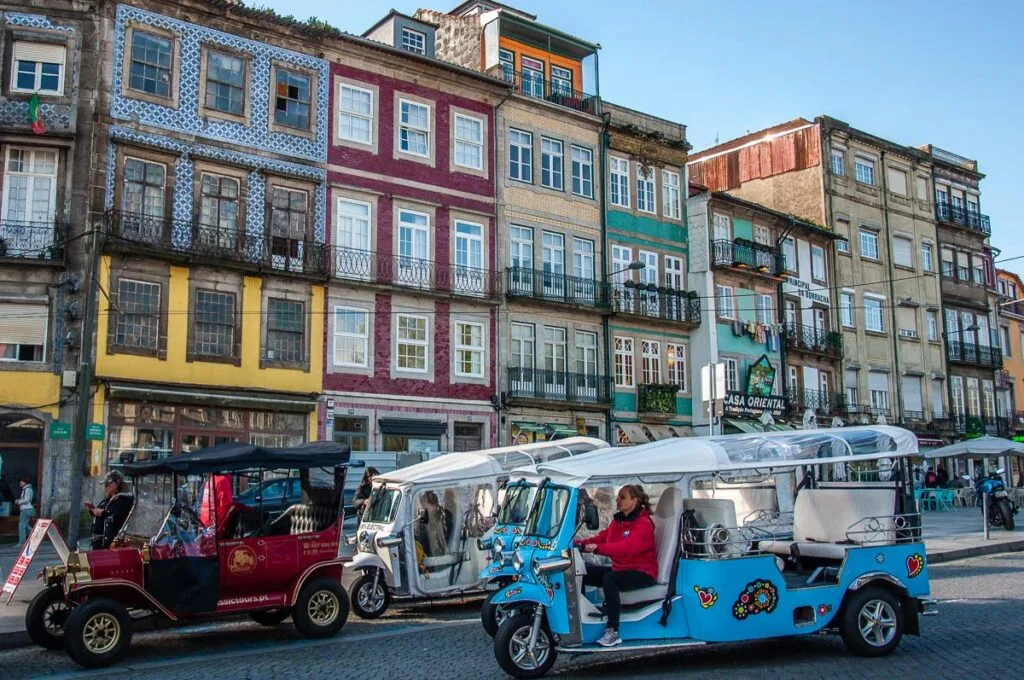
Are you planning a visit to Portugal and wondering if taking a day trip to Porto is a good idea?
The answer is a resounding yes and this blog post gives you exhaustive details on how to make your day in Porto a success. From how to structure your time in the city so as to see its major landmarks and several of its hidden gems to how to reach Porto from anywhere in Europe and Portugal, this page is packed with helpful information to make your travel planning a breeze.
Portugal’s second-largest city has a lot to offer to travellers seeking to experience the best of the country’s sights, views, and cuisine. This is a vibrant and modern city built around a striking historic centre where you can travel centuries back in time.
I hope that all the travel information I shared in this blog post with you will come in very handy and that you will have a great time visiting Porto for a day (or a few)!
Enjoy Portugal’s second-largest city!
Now, get ready quick for your trip to Porto in Portugal!
- Consult these guidebooks.
- Buy plane tickets.
- Book train tickets, bus tickets or rent a car.
- Research accommodation.
- Select local tours and activities.
More Helpful Travel Info for You
Best of Portugal: Photos of Porto, One Day in Aveiro, Photos of Aveiro, One Day in Guimarães, Photos of Guimarães, Photos of Braga, Sanctuary of Bom Jesus do Monte, Best Portuguese Desserts and Pastries
Best of Italy: Venice, Lake Garda, Veneto, Lombardy, Emilia-Romagna, Marche, Friuli Venezia Giulia, Trentino, Italy with Kids, Italy for Foodies, Day Trips in Italy, Hiking in Italy, Christmas in Italy
Best of England: London, Kent, Dorset, East Sussex, Days Out in England
Travel: Travel Resources, The Joy of Travel, Safety Tips
Pin This Blog Post!
